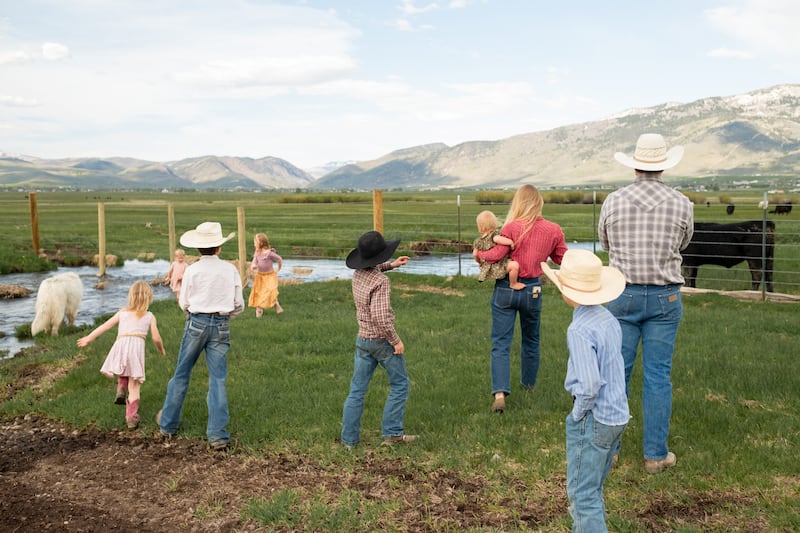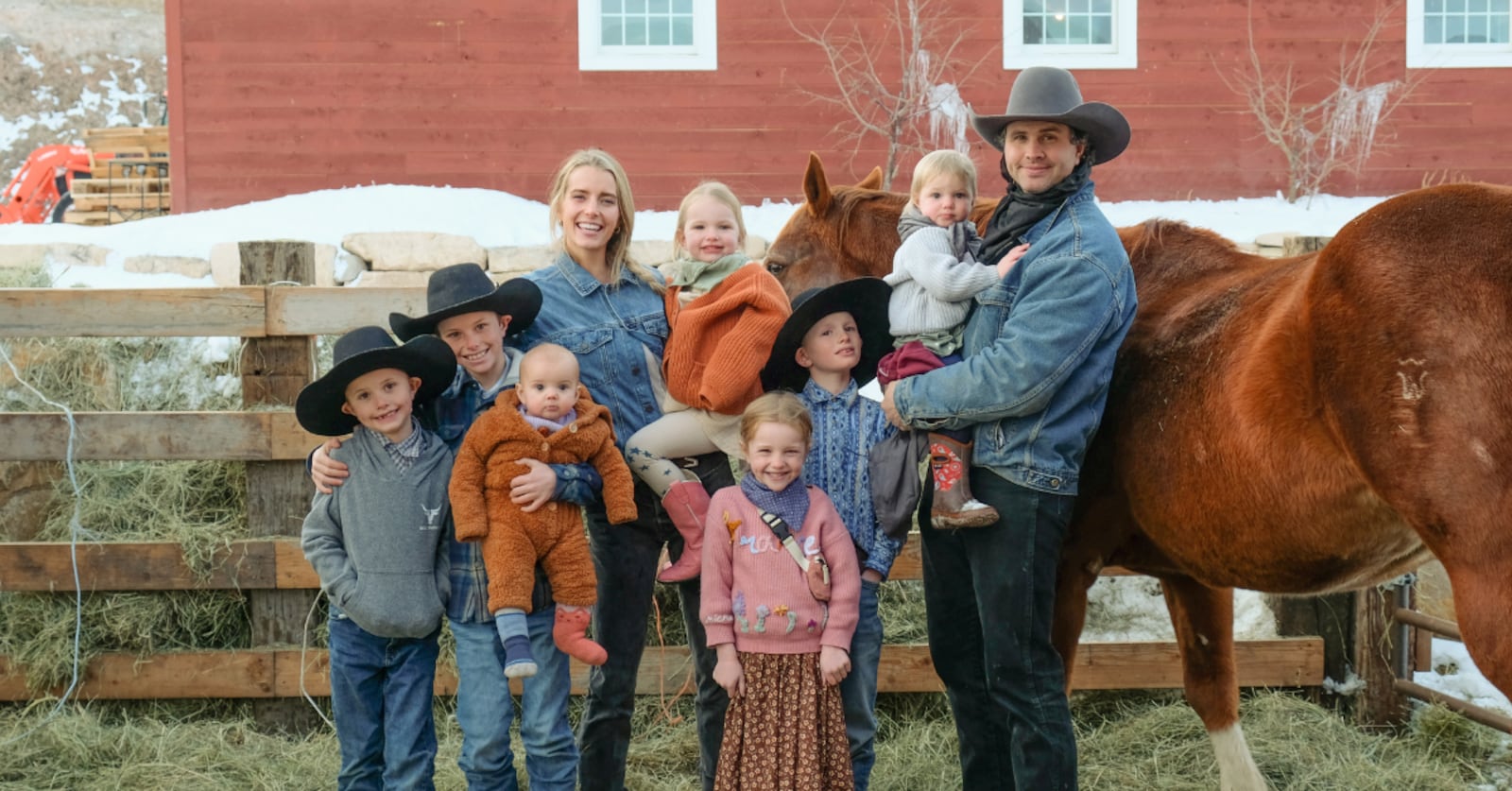This story appears in the March issue of Utah Business. Subscribe here.
The day I drive from Salt Lake City to Kamas, Utah, the city is covered in a layer of winter inversion so thick it obscures the end of the nearest block. Just 43 miles away on Daniel and Hannah Neelemans’ 330-acre homestead, however, the air is clear enough to see the distant snow-capped peaks of the Uinta Mountains. The breeze smells of damp hay and manure. The family dairy cow, Tulip, waits patiently for her afternoon milking. A riding arena beckons warmer days and rodeo practice. “Mountain-raised” Berkshire pigs graze freely among the sagebrush on the hillside, the largest of which will soon go to harvest.
Through the direct-to-consumer company Ballerina Farm, first-generation farmers Daniel and Hannah Neeleman don’t just sell breakfast sausage, sourdough starters and beeswax candles — they sell farm life. Ballerina Farm has amassed over 10 million followers on Instagram and YouTube who use Hannah’s posts about milking cows and churning butter as a digital portal to a more slow-paced, earthbound lifestyle.
Soon, through the opening of a 14-acre agricultural tourism (agritourism) site on the main highway in Kamas, these followers will be able to experience Ballerina Farm in person — making the Neelemans the latest participants in a growing agritourism industry that benefits both farmers and visitors.
Field to fork
“It’ll be a place people can come and see agriculture in action,” Daniel says of the Ballerina Farm agritourism site, which is currently under construction. An opening date has not yet been announced. “I don’t want it to be a petting zoo; I want it to feel like a working farm. You come and see a pig, and six months later, that pig will not be there, right? He’s moved on. He’s now bacon. Most of the animals on the farm will live part of their life there.”
At the brick-and-mortar Ballerina Farm store, visitors will be able to purchase perishables like beef, pork, chicken eggs, croissants and other baked goods, as well as online bestsellers like linen aprons, enamelware, lard dish soap and sourdough-making kits. Construction is also underway for a Ballerina Farm dairy building and creamery, where the Neelemans will eventually produce milk, ice cream and butter that will be available for purchase.
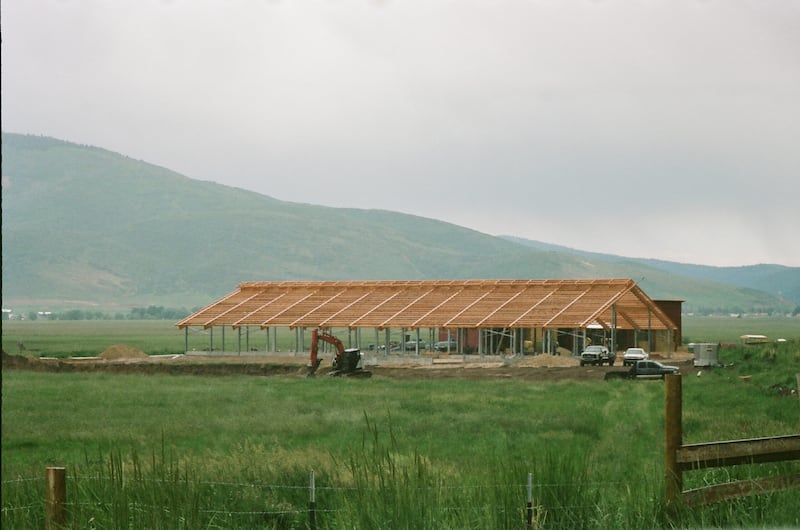
Like many agritourism operations, the site will hopefully lure Utah residents and visitors to spend their dollars in the rural town of Kamas — a town they otherwise might not think of traveling to — and provide jobs to the area.
According to a February report from the Kem C. Gardner Policy Institute, Utah visitors spent a record $11.98 billion in 2022. Though it is rarely the primary reason for visiting, agritourism operations allow farmers and rural communities to capture some of this revenue. The United States Department of Agriculture’s 2022 census found that agritourism generates $13.7 million for Utah farmers annually, or about 15 percent of a farm’s total income on average.
“I’m not worried about attracting visitors,” Daniel says. “I think it’s going to be really easy for people to come up here, just 45 minutes from Salt Lake, and spend an evening in the summer or a Saturday afternoon. … I used to think the interest from friends and family in coming to see the farm was tied to Utah’s pioneer ancestry, but the more I’m around, the more I see everyone has it. It’s all over the country and all over the world.”
This widespread interest in farm life is quantified by the number of Ballerina Farm Instagram followers that live outside of the United States — over half, according to Daniel. Given these statistics, Hannah is excited to provide a gathering place not just for visitors but for her neighbors, as well.
“Over the last couple of years, we’ve felt the desire to add something tangible to the local community,” she says. “About 90 percent of our products leave Utah, so it’ll be nice to have something for the people of Kamas, Park City and Salt Lake.”
The trend toward agritourism
According to the 2022 Census of Agriculture, agritourism generates $1.2 billion nationwide annually. With a compound annual growth rate of 13.4 percent, the industry value could reach $141 billion by 2030, according to Straits Research.
What spurs this unprecedented growth? Tamra Watson, Utah’s Own program manager at the Utah Department of Agriculture and Food, has a theory.
“For the first time in most of our lives, we saw grocery store shelves empty during the COVID-19 pandemic,” she says. “Suddenly, we’re seeing that the general public has a renewed interest in ensuring farms are close … and they want to ensure that those farms provide healthy [food] options for their families.”
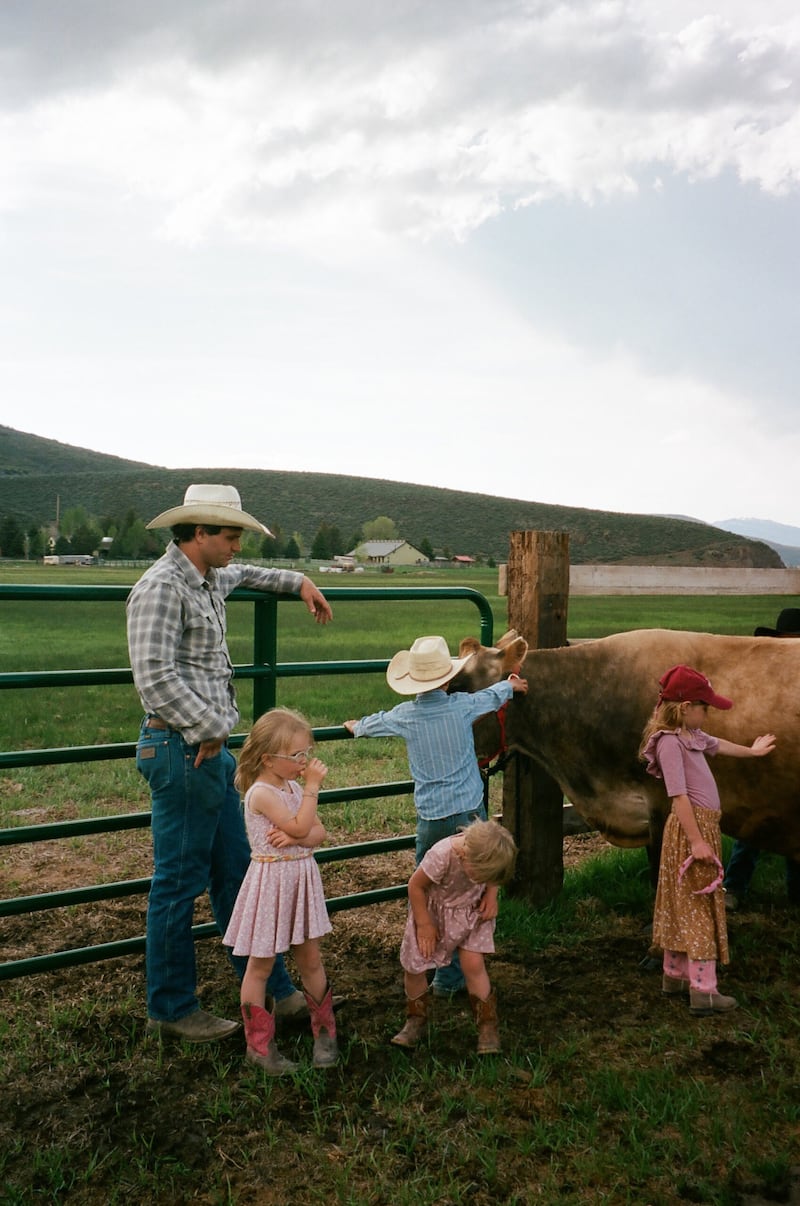
Watson says subscriptions to community-supported agriculture programs — or CSAs, a method of buying local food directly from farmers — tripled in 2020. Watson says more people are also eating local meat and attending farmer’s markets post-pandemic than before 2020.
“Then, from the operator side, farmers and ranchers are not as comfortable with debt as they once were,” Watson continues. “A lot of them are looking to diversify their revenue, especially their offseason revenue. That’s why they’re exploring more options with the public.”
Whereas “agritourism” might have referred to a U-pick orchard, pumpkin patch or corn maze in the past, the definition of the word has expanded in recent years. Today, farmers are getting creative with their offerings and hosting dairy farm tours, sunflower festivals, sourdough bread-making classes, winery tours, wild floral craft classes and more.
“To us, agritourism is anything that’s going to immerse you in the experience of a farm,” Watson says. “I’ve loved seeing how people are diversifying the offerings they’re giving to the public. Instead of competing with one another, they’re finding their niche.”
Weathering the farmland decline
Caroline Hargraves, director of the marketing and economic development division at the Utah Department of Agriculture and Food, says agritourism can often make or break a farm’s ability to remain in operation.
“Farms that offer agritourism activities attract visitors to unique areas and increase the length and spending of their stay,” she continues. “One of the most important aspects of agritourism is that, when visitors develop a connection with local agriculture, they’re more likely to continue to spend their money supporting local farms and food businesses.”
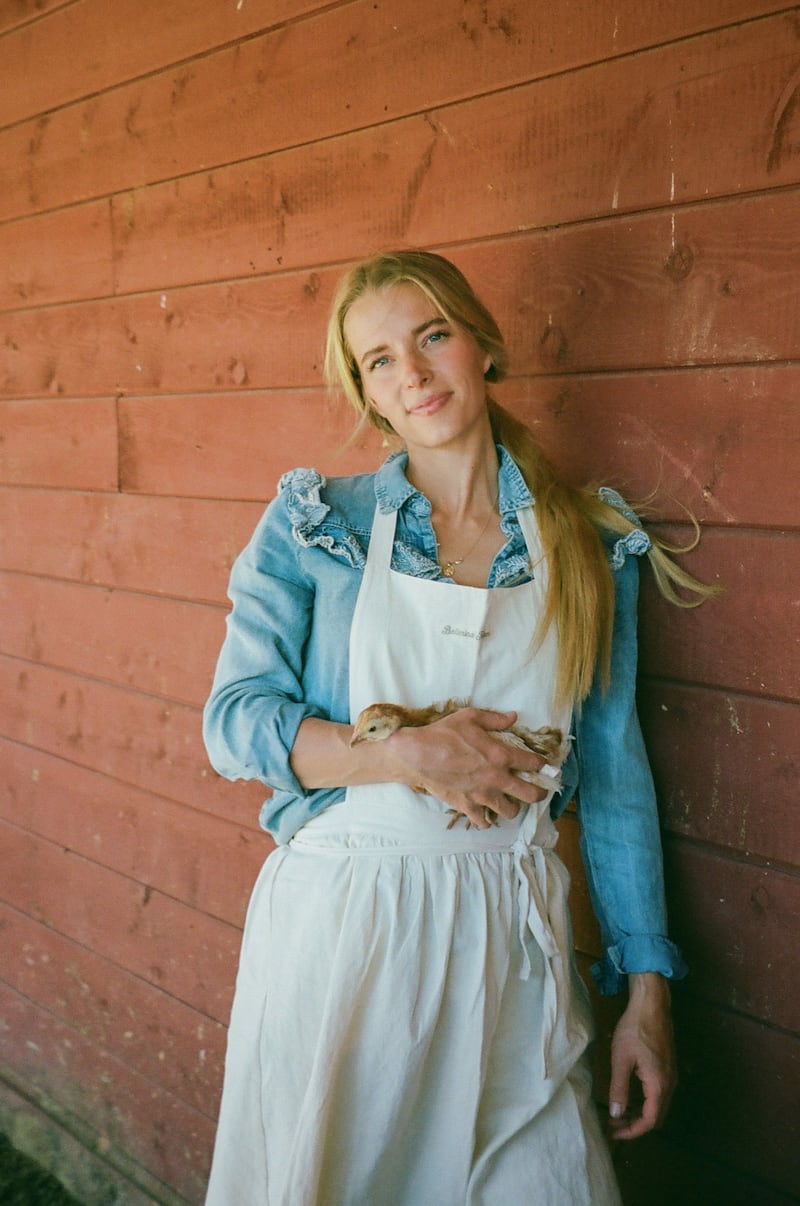
Hargraves says hands-on agritourism experiences like workshops and summer camps are growing in popularity. More farmers are opening farm stores on their properties, and renting land for weddings and photoshoots has become an easy way for farmers to make extra cash.
“There’s a really low barrier to entry for agritourism,” she says. “Often, you’re just inviting people to take part in what you’re already doing. … You don’t need tens or hundreds of thousands of dollars in infrastructure to make it happen.”
Agritourism can be a piece of the agriculture-saving puzzle. According to a report by Envision Utah, the situation is dire: Utah produces only 2 percent of the state’s needed vegetables, 3 percent of its needed fruit and 25 percent of its needed dairy.
According to the 2022 Census of Agriculture data, Utah lost 1,023 farms and 316,681 acres of farmland between 2017 and 2022. During this same time frame, farmland across the U.S. decreased by 20 million acres.
“It seems like it might just be a fun afternoon, but agritourism really could play an important role in preserving farmland in the state,” Hargraves says. “One of the biggest challenges in agriculture is making it appealing and economically viable for young people. It’s hard work and a 365-day job, but with influencers making the lifestyle look appealing, more people want to have even a small homestead. Agricultural land loss is such a major issue. What if we can get people to participate in agriculture and preserve even a couple of acres? What if 100 people do that?”
A farmer’s (digital) footprint
With millions of followers, Ballerina Farm is one agricultural operation with considerable influence — and its audience continues to grow.
“The show has definitely gotten bigger,” Daniel says. “I used to wear all the hats, and we’ve slowly brought people on to help us wear some of those.”
Today, the ranch itself employs three full-time workers, according to Daniel. Behind the scenes, Ballerina Farm employs approximately 20 full-time employees who work in fulfillment, customer support, marketing, website design, purchasing and product development.
Hannah says marketing products through farm education was always the game plan.
“We’ve always done agritourism in a way, even in the very beginning, through social media,” she says. “That was our business model: I’d build an Instagram, and we’d ship out boxes. … Sharing the story of how food gets to your table has always been our superpower.”
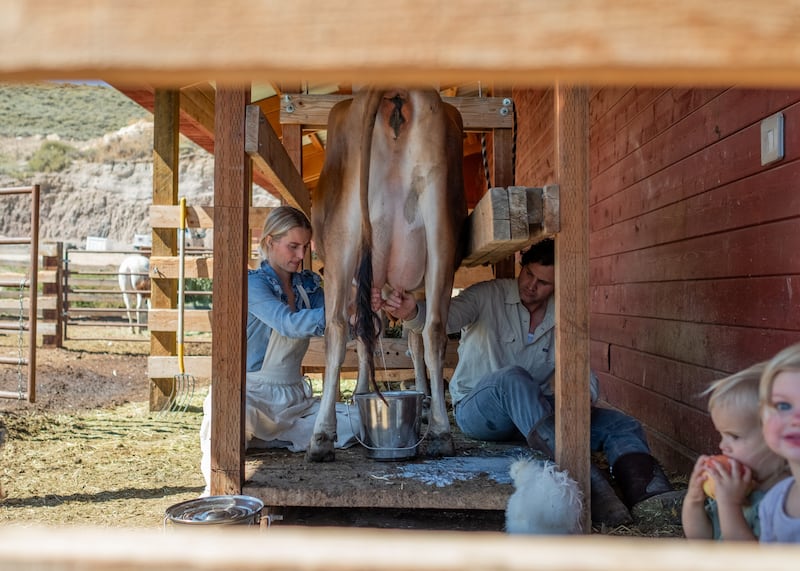
Farm operations look much different today than six years ago when the Neelemans started Ballerina Farm with just four pigs. The Neelemans cite 2020 as the year Ballerina Farm really took off — with more people cooking at home during the COVID pandemic and grocery store shelves empty, ordering meat online and having it delivered became a popular option.
“The pandemic also seemed to give people this desire for a slower pace and more independence and self-reliance,” Hannah says. “That’s when everyone started making their own sourdough, and we started selling sourdough kits and kitchen utensils. It’s crazy to see our sourdough starters shipping all over the world. People in New York City are making their own bread.”
As a Juilliard-trained ballerina, Hannah was once a city dweller herself. Today, she hopes those following along with her journey will feel inspired to “consume less and create more,” regardless of whether they have farmland of their own.
“There are so many lessons that farm life teaches, and I hope visitors will be able to take something from the farm back to their lives,” Hannah says. “We’ve become so far removed from our food, and agriculture has a lot of eyes on it right now. We want people to invest in farmers and know where their food is coming from. I think getting the full picture — educating people on what it takes to get food to the table, how the animals are being treated, how they’ve been raised — will be empowering for all of us.”
